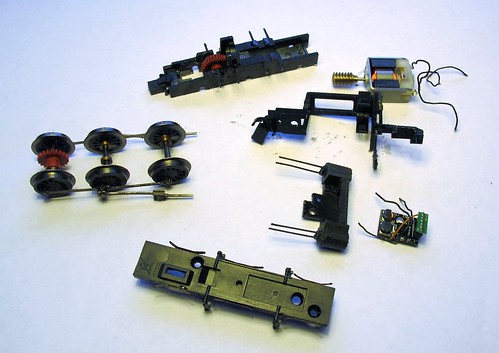A daily updated blog typed by someone with painty hands, oil under his fingernails and the smell of solder in his nostrils who likes making all sort of models and miniatures. And fixing things.
Friday, December 11, 2015
The guts of an Electrotren
If you are as stupid as me, you don't always pay attention when dismantling a model locomotive.
If the loco concerned is an Electrotren and you try to pull the baseplate off, you'll stretch the wires that pass up through the cast chassis. This allows the insulation to pull back and the positive and negative electric juice to escape, meeting each other in a sparky way that DCC controllers just don't like.
If you saw the model at Doncaster you'll know it wasn't running. For Warley I decided to fix it, partly prompted by the promise that the manufacturer of the resin body would be visiting.
Anyway, I carefully unscrewed and unclipped everything with the results you see above. Apart from some fiddling popping the waggly bits back into the slide bars, it's not too bad a job. I rewired with the thinnest wire I had to hand and double insulated the exposed wire at the top of the pickups with blobs of superglue - just to be on the safe side.
Once reassembled, the model runs sweeter than such a cheap chassis has any right to, especially one with such a cheap 3-pole motor. I've kit built chassis that don't work that well and they have "proper" motors in them. Grrrr.
Labels:
model railway
Subscribe to:
Post Comments (Atom)

2 comments:
I know that some people get really sniffy about other people using cheap RTR chassis (and other parts) in their models.
Some seem to take the line that a modelmaker can't possibly be a proper modelmaker - their models can't possibly be proper models - unless their models all feature chassis hand built at home from raw materials, gears produced at home on a lathe, that sort of thing.
Some of the comedians who peddle this line might grudgingly accept the possibility of said chassis being replaced on one model by the poshest kit chassis on the market - especially if said chassis features some exotic "fad" motor - Portescap 1219 / Escap RG4, anybody?
This is all well and good for the few people who can build stuff like this - who can afford the finest components - who have had plenty of practice in making the most of them - but where does this leave the rest of us?
Actually, I know exactly where this leaves the rest of us - in good company.
I've seen a number of perfectly acceptable models - at exhibitions - also at club open days - running on good quality layouts - actually running very well - yet powered by nothing "better" than a Hornby "Smokey Joe", obtained secondhand for next to nothing.
In fact, I'm aware of a number of "show" layouts which only use motive power similar to this - but most show visitors would never realise this unless somebody told them.
There might even be advantages in using the cheapest, most readily available, RTR drives when building kit / scratch built locos and railcars. What happens if your pride and joy is running at an exhibition - then suddenly stops running? You don't have time to do major repairs, or build a new chassis.
If you're using a "Smokey Joe", you don't need to - you just go to the nearest secondhand stall or boxshifter - get the cheapest example you can find - play around with a screwdriver for a few seconds - and you're back in business.
There's nothing to stop you doing some repairs when you get home (to get a spare chassis), but these things are often so cheap that it's barely worth the effort.
I could also make similar comments about other cheap RTR chassis - but I wonder if it might be better to leave the real comments to the magazines and the guys who write the "how to" articles. A recurring feature about how to do kit / scratch build conversions of cheap RTR chassis could be quite interesting - even if some of these conversions are into O-16.5 / Oe / On30 and based on (horror of horrors) a Hornby Pacer chassis (in much the same way as one railbus I'm currently working on).
That's right - I'm certainly no snob, when it comes to what I'll use. There's nothing wrong with the high-end stuff - but, for me, the "best" chassis, the "best" parts, are the most appropriate ones. If they also happen to be the cheapest, I view this as a bonus.
There's nothing wrong with using a RTR chassis for a model IF it does the job. There used to be many horrible kits where everything had been distorted to fit a Jinty 0-6-0 chassis - in fact that could have described the Hornby rnage many years ago.
A good RTR chassis makes a great basis for a loco. You can concentraite on building the body confident that the loco will work once you've finished.
Of course, eventually you'll want to build something where a bespoke chasis is required and then it's time for kitbuilding fun, but with some kits like this behind you, confidence will be much higher.
Post a Comment